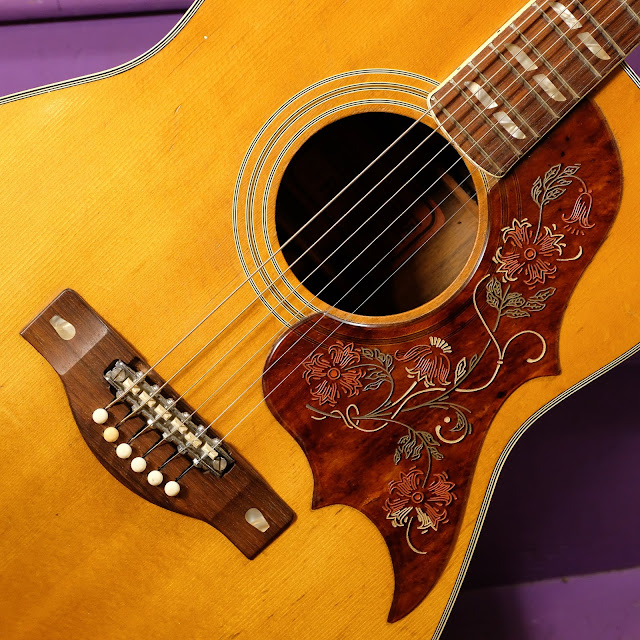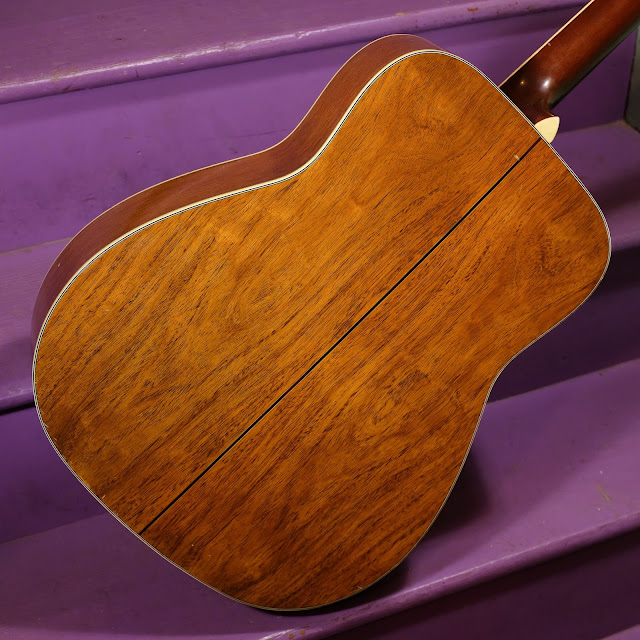1960s Yamaha FG-300 Jumbo Flattop Guitar
This "red label" FG-300 was probably built in '69 or '70. At the time, this was the fanciest Yamaha jumbo you could buy and it's kitted-out with a nice hummingbird-style pickguard, cool inlay in the board, binding all over the place, and ply-rosewood back and sides. It also has a fully-adjustable bridge unit that's light enough in weight to be useful -- instead of sounding worse than the standard-saddle Yamahas from the time, it sounds just as good or better. I honestly think there's something about metal bridge inserts on ply-top guitars that warms-up the tone for the better. I've been noticing that I'm drawn to the sound of the adjustable-bridge import guitars from the time because of that.
Anyhow, this one is in good shape and entirely original save one bridge pin. It has plenty of average usewear throughout but no dramatic wear and tear. Overall it feels friendly and lived-in.
Tone is big, full, wide, and round. The highs and upper-mids are a little scooped but it makes a great strummer or cowboy-chord backing-up guitar. A fellow was fingerpicking it in the shop the other day, though, and I thought it had a nice, sweet tone for that, too.
Work included: a neck reset, fret level/dress, pickguard reglue, string ramp additions at the bridge, minor cleaning, tuner servicing, and a setup. It plays bang-on with 3/32" EA and 1/16" DGBE action at the 12th fret, has a straight neck, and is strung with 54w, 40w, 30w, 22w, 16, 12 gauges at the moment.
Scale length: 25"
Nut width: 1 3/4"
String spacing at nut: 1 7/16"
String spacing at bridge: 2"
Body length: 19 3/4"
Lower bout width: 16 1/4"
Upper bout width: 11 1/2"
Side depth at endpin: 4 1/2"
Top wood: ply spruce
Back/sides wood: ply rosewood
Bracing type: x-braced, lightly-cut
Fretboard: rosewood
Bridge: rosewood
Neck feel: slim-to-medium C, ~16" radius
Condition notes: there are minor scuffs, small dings, and light scratches throughout, but they're not obvious (check the pics). There's a tiny replacement patch of binding way at the end of the fretboard near the soundhole. You won't notice it. The frets have plenty of life left to go and are only slightly shorter than they left the factory. The truss rod is adjusted nearly to the maximum of its limit, so if you're thinking of stringing with 56w-13 gauges -- you probably will run out of thread to adjust for the extra tension. I suggest 52w-11 on old Yamahas as standard (they're built light), but have used a custom set that bumps the low E and high B&E to give more of the feel of 12s. There's also one section along the lower-bout back seam where the veneer of rosewood lifted off of the back and someone reglued it -- but not perfectly. I didn't even catch this until I started taking pictures of it, so no worries.





















Comments
Gr8 job Jake San..those old Japanese guitars used some secret special recipe in there laminate
Sounds juicy
Per Ardua
As I mentioned in your other FG 300 post, I think this one was most likely manufactured in Taiwan in 1972. Yamaha moved production of the FGs to Taiwan in that year, apparently in the second half of the year. They would soon switch to tan labels for Taiwan-made made guitars, but for a brief period of time, they kept the red labels, but omitted the “Nippon Gakkai” notation, indicating that the guitar was built in Japan.
Red label Japanese made Yamaha FGs are much sought after, but I think that’s selling the Taiwan models short. My first “real” guitar was a Taiwan made 1977 FG 340, and it’s remarkably sweet sounding for a plywood guitar. I absolutely love my FG 300, but that FG 340 has a special place in my heart, red label, tan label, whatever.
Keep up the great work on the vintage models! I really enjoy you sharing your work with everyone.